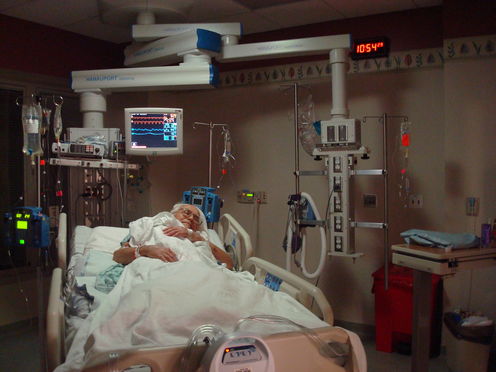
Where do you want to die? Provided symptoms can be controlled, most people at the end of life prefer to die at home. However, just over half of Australians who died in 2011-12 died in hospital.
In the same year, about A$2.4 billion was spent on hospital care for people aged 65 or older in their last year of life. But only a small fraction of that amount is spent supporting people to die at home.
Public money is being wasted on ineffective and inefficient treatments and health services which do not meet patients’ and families’ needs and wishes at the end of life.
This money would be better spent on palliative care services. Among other benefits, these more than double the chance of dying at home through the provision of home-based support services such as nursing.
Health funds spent on treatments and health services of negligible and questionable value, such as chemotherapy at the end of life, should be reallocated to palliative care services. This would improve our chances of dying well and in accordance with our wishes.
Palliative care is care provided to people living with a terminal illness where a cure is no longer possible. The aim of palliative care is to achieve the best quality of life possible for patients and their families during the illness and after death by relieving symptoms, addressing emotional, social and spiritual needs and reducing suffering.
This type of care is provided by teams of assorted professionals such as chaplains, doctors, nurses, pharmacists, physiotherapists and social workers. It is provided across all types of settings, including hospitals, hospices, residential care facilities and at home.
A recent report suggested investing A$237 million in providing palliative care services at home rather than in hospital wouldn’t raise the total health care spend but would increase the proportion of Australians dying at home from 14% to 30%.
High-quality palliative care is person-centred and compassionate. Emerging evidence suggests this type of care could even lower health costs, mainly by reducing hospitalisations at the end of life.
Palliative care in hospital
Inevitably, and appropriately, some people will need or desire hospital care at the end of life. The Australian Institute of Health and Welfare’s recent update on palliative care services in Australia showed that over the past ten years there has been a 52% increase in hospitalisations for which the main purpose of care is palliation.
This trend will continue rising due to our increasing, ageing population and earlier warning of death.
In 2012-13, 42% of people who died in hospital were receiving palliative care. Providing specialised palliative care in hospitals, particularly early on, can reduce hospitalisation costs by shortening the hospital stay and reducing intensive care and laboratory costs, as well as improving quality of life.
What about informal care?
In 2011-12, Australia spent A$140.2 billion on health. Roughly a third of total health costs is associated with people in the last year of life.
But this estimate does not include costs to the individual or their family. Recent research suggests as much as a third of total spending on caring for people at the end of life falls on family and friends.
Without the support of informal carers, home-based care at the end of life would often be unachievable. Smaller, more geographically spread out families, higher divorce rates and changing communities mean these support networks are likely to shrink at a time when the need for them is growing.
When planning health-care services in this setting, it is essential we also think about informal care costs. We need to make sure we avoid over-burdening families who are a vital part of end-of-life care.
Achieving a better death
Without adequate palliative and end-of-life care, people will continue to be cared for and to die in hospitals despite most Australians wishing otherwise. Patients will have a poorer quality of life at the end of life. Families will suffer unnecessarily. Care will not be provided efficiently.
We are all going to die, but how will we die? Investing in palliative care services will improve our chances of dying well and in accordance with our wishes.
Dr Nikki McCaffrey works for the Palliative Care Clinical Studies Collaborative (PaCCSC), a national collaboration of researchers conducting Phase III palliative care studies. She has previously been funded by the Australian Government Department of Health under the National Palliative Care Program to conduct economic evaluations in palliative care.
